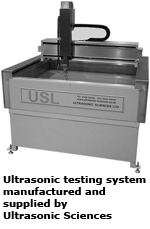Corus invests in high quality clean steels testing facility for the automotive bearing market
02/05/2007
 Corus, the international steel company, has invested in a new Ultrasonic Testing Laboratory to enable the further enhancement of the company's production capabilities of high quality, ultra-clean steels for the automotive bearing market.
Corus, the international steel company, has invested in a new Ultrasonic Testing Laboratory to enable the further enhancement of the company's production capabilities of high quality, ultra-clean steels for the automotive bearing market. The new laboratory-testing unit, part of on-going investment at Corus's engineering steel business at Rotherham, allows the company to more accurately assess the cleanness of steels produced. Equally important, as part of the group-wide Continuous Improvement Programme, it provides feedback to make refinements to the processing route on a regular basis.
Traditional methods for testing the cleanness of steel use a combination of ultrasonic and microscopic examination. Although this facilitates the testing of large volumes very quickly, the system only picks up inclusions with an ultrasonic echo down to 1.2 mm in size. Using the new ultrasonic testing system, Corus can now determine faster and more accurately the size and distribution of inclusions in the steel, down to an echo of 0.1 mm in size, and also trace the source of the inclusions within the manufacturing process. This now allows Corus to fine-tune steel making practices to eliminate inclusions, and the potential adverse affect on fatigue performance, without adding extra time to the manufacturing process.
Corus believes the new Ultrasonic Test Laboratory will also allow it to meet the increasing demands from manufacturers for ultra clean steels. Will Gamble, Senior Product Technologist Automotive Bearing Market, Corus Engineering Steels, said: "By improving the process by which we monitor the quality of steel we produce, we are more confident that Corus can consistently deliver the cleanness of material that meets the exacting demands of our customers."
Corus is now planning to apply the benefits of the Ultrasonic Test Laboratory to other steel products used in fatigue or safety critical automotive applications. This would provide downsizing, light-weighting or reliability benefits, resulting from consistent high levels of cleanness, for such components as gear sets and diesel fuel injectors.
The inspection system was manufactured and supplied by Ultrasonic Sciences Ltd (USL). It incorporates the latest PM30 pulser receiver board which, as evidenced by the Corus results, provides exceptional sensitivity to small defects. The same pulser receiver is also used in many large-scale industrial installations, usually in conjunction with multiplexers from 8 to 32 channels.